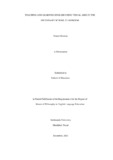
Please use this identifier to cite or link to this item:
https://hdl.handle.net/20.500.14301/154| Title: | TEACHING AND LEARNING ENGLISH USING VISUAL AIDS IN THE SECONDARY SCHOOL CLASSROOM |
| Authors: | Baskota, Prateet |
| Citation: | Baskota,P.(2021).Teaching and Learning English Using Visual Aids in the Secondary School Classroom. |
| Issue Date: | Nov-2021 |
| Publisher: | School of Education |
| School: | SOED |
| Department: | DOLE |
| Level: | M.Phil. |
| Program: | Master of Philosophy (MPhil) in English Language Education |
| Abstract: | In Nepal, visual aids are appreciated in today's education system, requiring students to study in the 21st century and in pandemic situations. It uncovers the student's skills in learning in the secondary school classroom. This research aims to unfold learners' experiences using the visual aids available in the textbooks and beyond in the learning process and assessment. More specifically, I intend to seek the answer to how learners learn the English language through visual aids in a classroom. Following narrative inquiry as to the research method, I collected the data through a series of interview sessions, casual conversations and class observations with four participants from one secondary school based on the North-eastern part of the Kathmandu Valley. I also observed their activities in the tutorial room, library, schoolroom, audio-visual laboratory, and computer test centre. For interpretation, analysis and discussion of the data, I read and reread them, searched patterns and saw the emerging themes and discussed them within the theoretical framework of Howard Gardner's 'Visual-Spatial Intelligence' theory of multiple intelligences with reference to the National Examination Board of Nepal. From the interpretation, analysis, and discussion of the data, I learned that learning a language like English through visual aids enables the learners to develop positive social skills, new techniques of reading habits in visual aids supporting the words of books, and learning constructing knowledge for life. Correspondingly, this new way of learning habits in P-Model Classroom changes the practices of students into visual literacy through technology-rich-environment scenarios in the classroom. In addition, the learning method creates a creative embellishment and fascination of students' creativity, making their classroom well-structured and engaging them in different techniques of creative works. So, this new way of learning habits supports students' efforts to understand content taught in the classroom. These findings also indicate the sturdy practice for secondary school students, which reduces the uncertain activities at the school by saving the teacher's time. Keywords: Visual Aid, English Language Education, Secondary School Classroom, Visual-Spatial Intelligence, Creative, Progressive Education, Narrative Inquiry and Qualitative Data, National Examination Board. |
| URI: | https://hdl.handle.net/20.500.14301/154 |
| Appears in Collections: | Dissertation |
Files in This Item:
| File | Description | Size | Format | |
|---|---|---|---|---|
| 16. NEB GRANT_ The Final One Phase 8 for BlackBook Binding Print.pdf | 5.7 MB | Adobe PDF |  View/Open |
Items in DSpace are protected by copyright, with all rights reserved, unless otherwise indicated.